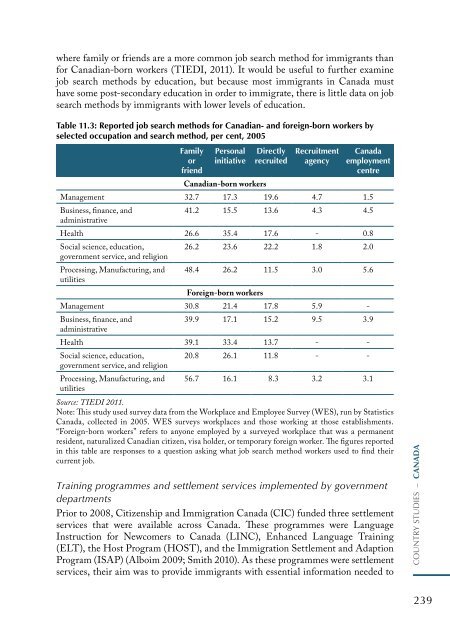International Organization for Migration (IOM)
International Organization for Migration (IOM)
International Organization for Migration (IOM)
Create successful ePaper yourself
Turn your PDF publications into a flip-book with our unique Google optimized e-Paper software.
where family or friends are a more common job search method <strong>for</strong> immigrants than<br />
<strong>for</strong> Canadian-born workers (TIEDI, 2011). It would be useful to further examine<br />
job search methods by education, but because most immigrants in Canada must<br />
have some post-secondary education in order to immigrate, there is little data on job<br />
search methods by immigrants with lower levels of education.<br />
Table 11.3: Reported job search methods <strong>for</strong> Canadian- and <strong>for</strong>eign-born workers by<br />
selected occupation and search method, per cent, 2005<br />
Family<br />
or<br />
friend<br />
Personal<br />
initiative<br />
Directly<br />
recruited<br />
Recruitment<br />
agency<br />
Canada<br />
employment<br />
centre<br />
Canadian-born workers<br />
Management 32.7 17.3 19.6 4.7 1.5<br />
Business, finance, and<br />
administrative<br />
41.2 15.5 13.6 4.3 4.5<br />
Health 26.6 35.4 17.6 - 0.8<br />
Social science, education,<br />
government service, and religion<br />
26.2 23.6 22.2 1.8 2.0<br />
Processing, Manufacturing, and<br />
utilities<br />
48.4 26.2 11.5 3.0 5.6<br />
Foreign-born workers<br />
Management 30.8 21.4 17.8 5.9 -<br />
Business, finance, and<br />
administrative<br />
39.9 17.1 15.2 9.5 3.9<br />
Health 39.1 33.4 13.7 - -<br />
Social science, education,<br />
government service, and religion<br />
20.8 26.1 11.8 - -<br />
Processing, Manufacturing, and<br />
utilities<br />
Source: TIEDI 2011.<br />
56.7 16.1 8.3 3.2 3.1<br />
Note: This study used survey data from the Workplace and Employee Survey (WES), run by Statistics<br />
Canada, collected in 2005. WES surveys workplaces and those working at those establishments.<br />
“Foreign-born workers” refers to anyone employed by a surveyed workplace that was a permanent<br />
resident, naturalized Canadian citizen, visa holder, or temporary <strong>for</strong>eign worker. The figures reported<br />
in this table are responses to a question asking what job search method workers used to find their<br />
current job.<br />
Training programmes and settlement services implemented by government<br />
departments<br />
Prior to 2008, Citizenship and Immigration Canada (CIC) funded three settlement<br />
services that were available across Canada. These programmes were Language<br />
Instruction <strong>for</strong> Newcomers to Canada (LINC), Enhanced Language Training<br />
(ELT), the Host Program (HOST), and the Immigration Settlement and Adaption<br />
Program (ISAP) (Alboim 2009; Smith 2010). As these programmes were settlement<br />
services, their aim was to provide immigrants with essential in<strong>for</strong>mation needed to<br />
country studIes – CANADA<br />
239


